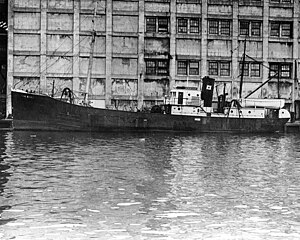USS Pigeon (AM-374) was an Auk-class minesweeper acquired by the United States Navy for the dangerous task of removing mines from minefields laid in the water to prevent ships from passing.

USS Sprig (AM-384) was an Auk-class minesweeper acquired by the United States Navy for the dangerous task of removing mines from minefields laid in the water to prevent ships from passing.

USS Speed (AM-116) was an Auk-class minesweeper acquired by the United States Navy for the dangerous task of removing mines from minefields laid in the water to prevent ships from passing.

USS Cardinal (AM-67) was a Bullfinch-class minesweeper in the United States Navy during World War II.
The first USS Flicker (AM-70) was a minesweeper in the United States Navy during World War II, named after the flicker, a medium-sized member of the woodpecker family common to North America.
USS Bullfinch (AM-66) was a Bullfinch-class minesweeper of the United States Navy during World War II.
USS PCS-1465 was a PCS-1376-class minesweeper built for the United States Navy during World War II. Late in the war she was renamed and reclassified Minah (AMc-204), and in the 1950s reclassified first as AMCU-14 and later as MHC-14. Named for the myna under a variant spelling, she was the only U.S. Navy ship of that name.
USS Goshawk (AM-79), was a Goshawk class minesweeper built in 1919 as the steel-hulled fishing trawler M/V Penobscot by the Foundation (Marine) Co., Savannah, Georgia, for Mr. W. F. Henningsen, Seattle, Washington.

USS Sandpiper (AM-51) was a Lapwing-class minesweeper. Laid down on 15 November 1918 at the Philadelphia Navy Yard, Philadelphia, Pennsylvania, and launched on 28 April 1919, USS Sandpiper was commissioned on 9 October 1919, redesignated AM-51 on 17 February 1920, and reclassified as a Small Seaplane Tender, AVP-9 on 22 January 1936.
USS Catbird (AM-68) was the lead ship of her class of two naval trawlers, which were operated as minesweepers by the United States Navy during World War II.
USS Albatross (AM-71) was an Albatross-class minesweeper of the United States Navy during World War II.
The Kite-class minesweepers were a class of two ships operated by the United States Navy during World War II.
USS Linnet (AMS-24/YMS-395) was a YMS-1-class minesweeper of the YMS-135 subclass built for the United States Navy during World War II.
USS Grackle (AM-73) was a minesweeper in the service of the United States Navy during World War II.
USS Kite (AM-75) was the lead ship of her class of minesweepers of the United States Navy during World War II.

USS Kite was a YMS-1-class minesweeper of the YMS-135 subclass built for the United States Navy during World War II.

USS Dour (AM-223) was an Admirable-class minesweeper built for the United States Navy during World War II. She was awarded three battle stars for service in the Pacific during World War II. She was decommissioned in March 1947 and placed in reserve. While she remained in reserve, Dour was reclassified as MSF-223 in February 1955 but never reactivated. In October 1962, she was sold to the Mexican Navy and renamed ARM DM-16. She was stricken from Mexican Navy service in 1986, but her ultimate fate is not reported in secondary sources.

USS Bluebird (AM-72) was an Albatross-class minesweeper acquired by the U.S. Navy during World War II for clearing minefields during fleet operations.
USS Goldfinch (AM-77) was a minesweeper acquired by the U.S. Navy for the dangerous task of removing mines from minefields laid in the water to prevent ships from passing.
USS Gull (AM-74) was a minesweeper acquired by the U.S. Navy for the dangerous task of removing mines from minefields laid in the water to prevent ships from passing.







